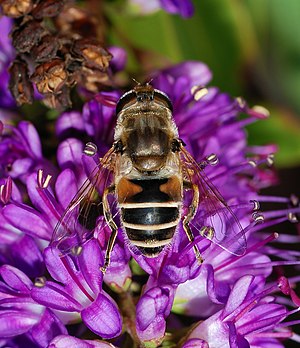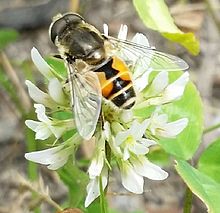Small wedge-spotted hover fly
| Small wedge-spotted hover fly | ||||||||||||
|---|---|---|---|---|---|---|---|---|---|---|---|---|

Small Wedge-Spotted Hoverfly - female |
||||||||||||
| Systematics | ||||||||||||
|
||||||||||||
| Scientific name | ||||||||||||
| Eristalis arbustorum | ||||||||||||
| ( Linnaeus , 1758) |
The small wedge- spotted hover fly or small bee hover fly ( Eristalis arbustorum ) is a fly from the family of hover flies (Syrphidae). It is one of the most common types of the family in Central Europe.
features
The flies reach a body length of 8 to 11 millimeters and are therefore smaller than the other species of the genus Eristalis . The face is light gray haired and dusted and has no black center line. The antennae are black-brown and have feathery bristles. The mesonotum is matt black, the scutellum is brown. The abdomen is black, the rear edges of the individual segments are brightly colored. The second and third abdominal segments are colored yellow-orange on the sides, creating a black “hourglass mark” in the middle, which is not as clearly pronounced as in other species of the genus Eristalis . The female has this yellow-orange coloration only on the second segment. The compound eyes are hairy and meet in the middle of the head of the males. The wings are transparent. The legs are colored matt black, with the tip of the thighs and the basal end of the rails being a broad rust red color. One can distinguish the kind of Eristalis abusiva by the long feathered antenna bristles. The splints ( tibia ) are yellow, but the last quarter of the middle pair of legs is black.
Occurrence and way of life
The species occurs from North Africa over Europe to Asia and also in North America in all habitats, especially in open areas. The adults are found on flowers from March to October, especially on those of basket and umbelliferae . The larvae develop in stagnant water, but also in liquid manure .
swell
literature
- Gerald Bothe: Hoverflies. German Youth Association for Nature Observation, Hamburg 1996.
- Joachim & Hiroko Haupt: Flies and mosquitoes: observation, way of life. Naturbuch-Verlag, Augsburg 1998, ISBN 3-89440-278-4 .
- Kurt Kormann: Hover flies and bubble-head flies of Central Europe. Fauna Verlag, Nottuln 2003, ISBN 3-935980-29-9 .

